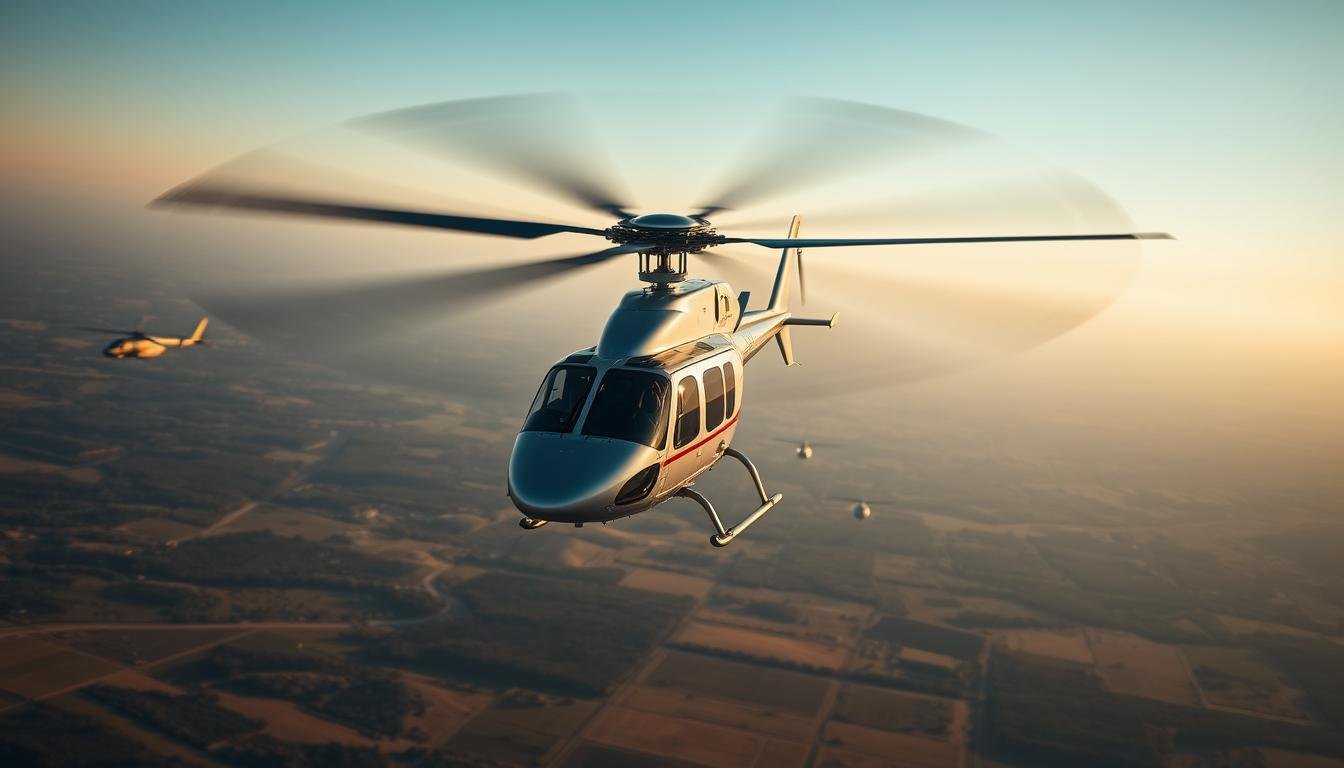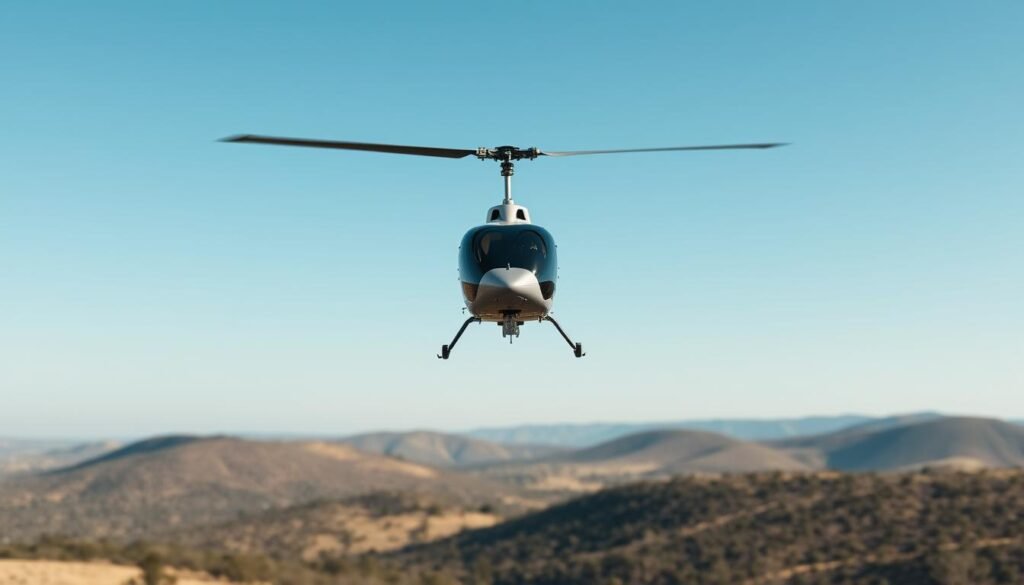Helicopter sound complaints affect major U.S. cities and national parks, with residents often reporting that rotor noise seems nearly twice as loud as other sources at the same decibel levels.
The issue matters because aerodynamic effects — not just engines — shape the ground footprint. Tip speeds commonly reach 600–700 ft/s, while the speed of sound is about 1,100 ft/s. Blade vortex interaction, known as blade slap, becomes most pronounced on approach and creates sharp, impulsive tones.
Operators have addressed community impact for decades. The Helicopter Association International began the Fly Neighborly Guide in the early 1980s to encourage higher routing and quieter procedures. Aircraft designers add features like Fenestron, NOTAR, and advanced blade shapes to cut noise at the source.
Readers will find a clear roadmap: how noise forms in air, key mechanisms like blade slap, human perception, operational best practices, and where to get high-quality sounds for media projects. For a detailed technical review of blade/vortex interactions, see this NASA report: rotor noise mechanisms.
Key Takeaways
- Aerodynamics Drive Noise: Rotors, not engines, dominate the acoustic footprint.
- Blade Slap Is Critical: BVI causes sharp impulses, especially during approach.
- Perception Matters: Repetition and low frequencies make meters understate how loud people feel it is.
- Operational Fixes Work: Fly Neighborly practices still guide quieter flights today.
- Design Reduces Impact: Fenestron, NOTAR, and new blade designs lower community exposure.
Helicopter Sound Fundamentals: How Air, Pressure, And Vibration Create Noise
When blades move through the atmosphere they create waves of compression and rarefaction that reach listeners on the ground. These alternating pressure zones travel through air and require that medium; they cannot cross a vacuum.
Sound As A Mechanical Wave In Air
Sound is a longitudinal mechanical wave. At a crest, pressure rises; at a trough, it falls. The ear converts these tiny changes into electrical signals the brain reads as tones or alarms.
From Pressure Changes To Perceived Noise
Rotating components disturb surrounding air and cause periodic pressure impulses. Each blade passage adds a pulse and the rotor’s rhythm shapes the overall acoustic signature.
“Frequency, amplitude, and repetition rate determine whether a tone is perceived as neutral or annoying.”
At community distances, aerodynamic generation dominates while mechanical sources matter nearer the frame. Psychoacoustic factors mean two equal meters can yield different reactions.
| Element | Physical Role | Perceptual Effect |
|---|---|---|
| Frequency | Pitch of pressure fluctuations | High frequencies are sharp, low frequencies feel boomy |
| Amplitude | Pressure magnitude | Louder perception, greater annoyance |
| Repetition | Regularity of pulses | Creates tonal, intrusive patterns |
For a technical overview of flight-vehicle noise generation, see noise of flight vehicles.
Types Of Rotor Noise: Rotor Blades, Blade Slap, And Engine Sources
Acoustic output from a rotor depends on how blades interact with air and each other. This section breaks the sources into clear categories so readers can see what drives community exposure and what designers try to change.
Thickness Noise And Loading Noise From Rotors
Thickness noise comes from air displaced in the rotor plane. It tends to radiate outward along the rotor disk.
Loading noise arises from lift and drag forces. That content focuses energy downward and often dominates what people hear under a flight path.

Blade Vortex Interaction: The Science Behind Blade Slap
Each blade sheds a tip vortex. At low speed or during descent a following blade can cut that vortex. The result is blade vortex interaction (BVI), heard as a sharp, impulsive blade slap.
“BVI concentrates acoustic energy downward on approach, making approaches the noisiest phase.”
Engine And Transmission Noise Versus Aerodynamic Noise
Mechanical sources like the engine and transmission matter close to the aircraft. At community distances, aerodynamic noise is dominant. Higher tip speeds (typical legacy VTOLs reach 600–700 ft/s versus ~1,100 ft/s for sound speed) raise overall levels and tonal content.
For a deeper look at industry responses and mitigation, see the science behind helicopter noise.
Perception, Annoyance, And Urban Flight Acoustics
Studies find that patterned blade harmonics and low bass energy amplify perceived loudness in urban settings.
Perception often diverges from meter readings. Many studies show people rate an event nearly twice as loud as decibel monitors report.

Why Helicopter Sounds Seem Louder Than They Measure
The brain reacts to tonal repetition and sharp pulses. This makes regular blade-passing frequencies stand out against city ambient.
Frequency, Repetition, And Low-Frequency Vibration Effects
Low-frequency energy transmits through structures and can be felt as vibration. That tactile element raises annoyance in homes and offices.
- Repetition: Drives attention and perceived loudness.
- Low Bass: Adds a tactile, in-room component.
- Urban Canyons: Reflect and prolong certain tones.
| Factor | Effect | Practical Term |
|---|---|---|
| Frequency Content | Makes tones stand out | Tonality |
| Repetition | Increases annoyance | Modulation |
| Low-Frequency Vibration | Felt indoors | Loudness |
Understanding these elements helps operators, regulators, and communities manage exposure in the sky and reduce annoyance over time.
Fly Neighborly: Operational Practices To Reduce Noise In The Sky
Operational choices matter. Simple changes to altitude, routing, and arrival profiles often lower community exposure more quickly than technical retrofits. The Fly Neighborly program (HAI, early 1980s) set voluntary standards that crews still apply today.

Altitude, Routing, And Approach Profiles
Increase altitude when safe: Greater slant range cuts perceived noise; flying at 1,000 ft can sound about half as loud as at 500 ft over the same point.
Route laterally away from sensitive sites: Bypass schools, parks, and dense neighborhoods to shift exposure to less sensitive areas.
Use approach and departure techniques that reduce BVI: Adjust descent rate, airspeed, and power to minimize impulsive rotor pulses during arrival.
Community Engagement And Model-Specific Guidance
Operators should tailor practices to each aircraft model because rotor, gearbox, and airframe differences change the acoustic footprint. The FAA’s noise certification rules (first in 1988) also guide design and operations.
“Transparent outreach and consistent complaint handling reduce tensions and improve acceptance.”
- Schedule flights outside early-morning and late-evening windows when possible.
- Train crews in acoustic awareness and record complaint data to refine routes.
- Coordinate with ATC and local officials to formalize low-noise corridors.
For operational safety and best practice cross-training, see this pilot resource on safe operations: top tips for pilots.
Technology Today: Fenestron, NOTAR, Blue Edge, And Electric Anti-Torque
Modern rotorcraft use an array of design tricks to move energy away from sensitive neighborhoods.

Shaping Rotor Blades To Reduce BVI
Blade shaping is a frontline tool. Swept, tailored tips like Airbus’s Blue Edge on the H160 reduce blade vortex interaction and lower impulsive arrival noise.
Dynamic hub phasing and exotic planforms change phase relationships so tonal peaks smooth out and blend with urban ambient.
Ducted And Distributed Propulsion For Lower Tip Speeds
Ducted rotors act as acoustic shields and can steer directivity away from people on the ground. Distributed electric propulsion spreads thrust across smaller rotors, letting designers run lower tip speeds and cut dominant tonal content.
- Tail solutions: Fenestron lowers the anti-torque signature; NOTAR removes the tail rotor entirely.
- Electric anti-torque: Bell’s EDAT uses multiple fans to reshape tonal content and reduce discrete tones.
- Trade-offs: Efficiency, weight, and certification constraints still guide integration choices.
“Even modest reductions in BVI and tonal components can reduce community complaints when paired with operational practices.”
For further technical context and community impacts, readers can consult detailed noise explanations and a practical overview of perceptual effects at why people perceive aircraft as louder.
Helicopter Sound Effects: Free Downloads, Quality Audio, And Use Cases
Creators can quickly assemble realistic rotor atmospheres using free libraries and simple generators. Mixkit and similar sites offer downloadable clips for prototypes and finished projects.

Free Helicopter Sound Effects Libraries And Generators
Sites provide hover rumbles, rapid flybys, and interior cockpit ambiences. Generators let users set length, reverb, and intensity to match scene needs.
Selecting Sounds For Game, Film, And Audio Projects
For film, match perspective: distant approaches for establishing shots and interior hum for cockpit dialogue clarity. For game use, layer loopable rotor beds with positional whooshes and dynamic EQ to simulate occlusion behind structures.
Range Of Helicopter Sounds: Hover, Flyby, Interior, And Ambient
A broad range of effects—hover, flyby, interior, ambient—covers urban canyons to open terrain. Check sample rate (48 kHz+), noise floor, clean loop points, and metadata for consistent timbre.
- Practical Tip: Use subtle convolution reverb for city reflections and low-frequency enhancement for tactile vibration.
- Live Workflows: SB1 Infinite Soundboard supports triggering and organizing clips by maneuver and distance.
- Licensing: Always verify terms; many free collections allow royalty-free use but may require attribution.
Conclusion
A clear path forward balances new rotor technology with everyday flight procedures to reduce community disturbance.
The evidence shows blade vortex interaction drives the loud approach signature, and aerodynamic sources outweigh the engine and transmission at community distances.
Tip speeds (commonly 600–700 ft/s versus ~1,100 ft/s for the speed of sound) remain a key lever. Combining swept rotor blades, Fenestron, NOTAR, and distributed or ducted designs with Fly Neighborly tactics lowers the perceived noise footprint across the sky.
Operators, regulators, and communities all benefit from transparent engagement and model-specific procedures. Media creators can rely on accurate sound effects libraries and generators to match perspective and preserve dialogue clarity.
For measurement context and guidance, see this measurement guidance. The best outcome pairs technology, operations, and outreach to keep missions effective while reducing complaints.
FAQ
What creates rotor noise and blade slap during flight?
Aerodynamic forces on the rotating blades generate pressure waves in air. When blade tips interact with vortices shed by preceding blades, sharp impulsive events called blade slap occur. Engines and gearboxes add mechanical tones, while loading and thickness effects change overall loudness.
How does air pressure translate into what people hear?
Pressure changes move through the atmosphere as mechanical waves. The ear detects variations in amplitude and frequency. Low-frequency components travel farther and feel like vibration, while higher frequencies provide the characteristic whop or chop of rotor rotation.
Which rotor noise types are most noticeable near urban areas?
Blade vortex interaction and loading noise are usually most intrusive. Repetitive tonal elements from transmission or engine systems add annoyance. Low-frequency content contributes to perceived loudness even when measured levels seem moderate.
Can operational choices reduce community disturbance?
Yes. Pilots can fly higher, use continuous descent approaches, and select routing that avoids populated zones. Smoother power management and reduced maneuvering over neighborhoods also cut down on impulsive and repetitive noise.
What design technologies help lower rotor noise today?
Innovations include Fenestron and NOTAR anti-torque systems, Blue Edge blade shaping to reduce blade-vortex interactions, and distributed electric propulsion that allows slower tip speeds. Improved gear and engine isolation also diminishes tonal emissions.
Where can audio engineers find free high-quality rotor recordings for projects?
Several sound libraries and community repositories offer free rotor and flyby samples suitable for games and film. Users should verify license terms, bit depth, and sample rate to ensure quality and legal use in commercial work.
How should one choose recordings for interior versus exterior scenes?
For interior scenes, prioritize low-frequency rumble, filtered engine tones, and subtle transmission artifacts. Exterior scenes benefit from full-spectrum flybys, Doppler shifts for realism, and separate files for hover versus fast forward flight.
Are there generation tools to create custom rotor effects?
Yes. Software synths and procedural generators model blade repetition, Doppler, and rotor-vortex interactions. Combining recordings with pitch modulation and layered ambience produces convincing, scalable assets for interactive media.
How does frequency and repetition affect annoyance levels?
Repetitive impulses and strong low-frequency energy increase perceived annoyance. Even if decibel measures are similar, regular, rhythmic thumps and sustained bass sensations make aircraft seem louder and more intrusive.
What terms should be checked when using free audio downloads?
Confirm license type, attribution requirements, allowed uses (commercial versus noncommercial), file format, and whether stems or multichannel files are provided. Also verify sample rate and bit depth for the intended production workflow.produce noise as a natural consequence of their mechanical design. This noise, while sometimes disruptive, is essential for their operation and a testament to the complex physics that allow these versatile machines to fly.
Related Articles
- Can Anyone Learn to Fly a Helicopter? Understanding Training and Skills Required
- Why Do Helicopters Make That Distinctive Sound? Helicopter Noise Explained
- Do Helicopters Require More Maintenance Than Airplanes? Separating Fact from Fiction
- How Far Can Helicopters Travel? Dispelling Range Myths
- What Happens if a Helicopter Engine Fails? Debunking Catastrophe Myths
More from This Category
- Are Helicopters More Dangerous Than Planes? A Safety Comparison
- Do Helicopters Have Parachutes? Exploring Emergency Systems
- Can Helicopters Fly Upside Down? The Truth Behind Aerobatic Stunts
- Do Helicopters Need a Runway? Myth vs. Reality
- How Much Does It Really Cost to Fly a Helicopter? Busting the Myths
- How High Can Helicopters Fly? Debunking Altitude Myths
- Can Helicopters Fly in Bad Weather? Understanding Helicopter Capabilities
- Do Helicopters Really Hover Forever? Separating Fact from Fiction
- How Safe Are Helicopters? Debunking Common Misconceptions
- Top 10 Myths About Helicopter Safety: What You Need to Know



